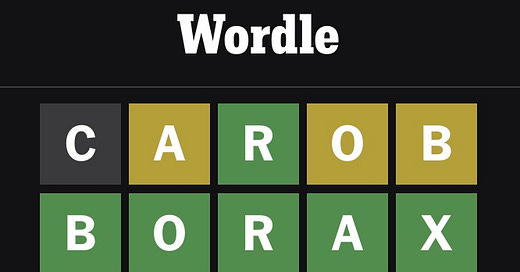Apologies to all of my 16 readers for the unexpected hiatus. We had a death in the family and frankly, it sucked and left us all with that feeling you get when you yank out the junk drawer too fast, everything flies everywhere and you wish you’d forked over $19.95 for that As Seen On TV junk drawer organizer a decade ago.
I’d planned to be crabby public health lady and caw at you about National Public Health Week in this issue, but I’m not in the headspace for it (and also NPHW is over), so instead we’ll go with my usual mourning ritual which is to blather about stupid shit while shoveling Chex mix into my face (follow me for more public health tips!). That said, I do plan to do a newsletter on grief as a public health issue soon, because it absolutely is.
What we talk about when we talk about carob
So I am on the Board of Directors of our local food co-op, and in our annual retreat last weekend we discussed what the future of food co-ops looks like now that every grocery chain and its mother sells Impossible Burgers alongside the possible burgers, something that still floors me.
“You could have told me 25 years ago that someday Donald Trump would be President of the United States and I would have believed that over Better Homes and Gardens flogging nutritional yeast,” I said.
“And carob,” said the General Manager.
My beady little eyes glittered. “Are people buying carob again?”
“Uh, no,” said the GM.
Ahh carob, the ersatz chocolate loved by sadistic 80s moms from coast to coast. Google carob and within the top 5 hits you always get the 2018 New Yorker article How Carob Traumatized A Generation (excerpted from Hippie Food: How Back-to-the-Landers, Longhairs, and Revolutionaries Changed the Way We Eat, an enjoyable read if you enjoy that sort of thing). Traumatized? Come on now, middle aged people. Did carob really traumatize you the same way Watership Down did?

Here are some pub trivia carob facts: largest producer of carob worldwide? Portugal. Where can you visit a 1,000-year-old carob tree? Malta. Only childhood food your friend Christine ever feels nostalgic for? Carob.
Like many children of the 1980s, it came into my life thanks to The Taming of the C.A.N.D.Y. Monster and was purchased, in chip form, alongside unappealing boxed falafel mix from a long-defunct health food store in West Park (of which I remember nothing else but half empty shelves and my first brush with capital-A austerity).
Somewhere in there, what I picked up on was that my mom was trying. Moms make you eat food out of love, even though sometimes they’re following misguided health advice. Your mom was not trying to torture you by yoinking away your Nestle Toll House cookies, she wanted you to live to adulthood, where I bet right now you’re pouring oat milk into your coffee while the ghost of Elsie the Cow lows mournfully.
If, and this is a big ask, you’re willing to give carob another shot, for the love of God, please meet it on its own terms. I suggest you go to a Middle Eastern grocery store and get yourself a jar of carob molasses, which is earthy and fruity not unlike prune whip, and mix it into your yogurt with some good tahini. This is called debs bi tahina and if my aging laptop wasn’t threatening to explode when I watch YouTube I would link a video here. (I’m sure you’re smart enough to find one yourself.) Or, if you’re feeling fancy, acquire a bottle of carob liqueur for your bar cart and dazzle your guests with a carob espresso martini. (“What’s your secret?” Wink, wink — you’ll never tell!)
Cheers
Here we are again, and the monster at the end of this Substack is still me. Thanks for reading and until next time,
CB
PS - Happy Belated Dyngus Day, dynguses







